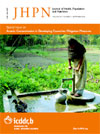
|
The Journal of Health, Population and Nutrition
icddr,b
ISSN: 1606-0997
EISSN: 1606-0997
Vol. 27, No. 6, 2009, pp. 772-783
|
 Bioline Code: hn09080
Bioline Code: hn09080
Full paper language: English
Document type: Research Article
Document available free of charge
|
|
|
The Journal of Health, Population and Nutrition, Vol. 27, No. 6, 2009, pp. 772-783
| en |
Risk Perception and Condom-use among Thai Youths: Findings from Kanchanaburi Demographic Surveillance System Site in Thailand
Haque, Mohammad Raisul & Soonthorndhada, Amara
Abstract
Youths, aged 15-24 years, comprise a large fragment of the total population in Thailand, and unsafe sexual
behaviours are increasing, nowadays, among young people. The study was conducted to explore the characteristics
of youths and other conducive, facilitating and reinforcing factors associated with risk perception
of sexually transmitted infections (STIs) among the study population. Data employed in this study
were derived from the site of the Kanchanaburi Demographic Surveillance System of Thailand 2004 using a
stratified systemic design. The study population was mainly young current condom-users aged 15-24 years,
and cross-sectional analysis was done on this populace. The findings revealed that youths who fell into the
single (unmarried) category having temporary partners were more likely to perceive the risks associated
with STIs in relation to using condom. A greater proportion of unmarried youths was engaged in sexual
activity before the age of 20 years and that condom-use was also inconsistent. Youths having temporary
partners were more likely to perceive risk and reason for using a condom than when with their regular
partner. Education played a significant role in risk perception of STIs. Risk perception was increasing with
the increasing level of education. Other conducive and facilitating factors, such as household wealth, living
in urban or semi-urban areas, and access to mass media such as television, also had a positive influence on
risk perception. The odds ratio showed that condom-users who had indulgence in liquor were less likely
to perceive the risk of STIs. Overall, socioeconomic status had a great influence on risk perception of STIs.
Finally, youths exhibiting high-risk sexual behaviour need realistic risk assessments and positive ways of
incorporating condom into their sexual lives.
Keywords
Condom-use; Education; Risk perception; Sexual partners; Youths; Thailand
|
| |
© Copyright 2009 - International Centre For Diarrhoeal Disease Research, Bangladesh
Alternative site location: http://www.jhpn.net
|
|
